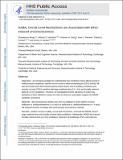GABAA circuit mechanisms are associated with ether anesthesia-induced unconsciousness
Author(s)
Akeju, Oluwaseun; Hamilos, Allison E.; Pavone, Kara J.; Song, Andrew H.; Brown, Emery Neal; Purdon, Patrick Lee; ... Show more Show less
Downloadnihms764300.pdf (1.907Mb)
PUBLISHER_CC
Publisher with Creative Commons License
Creative Commons Attribution
Terms of use
Metadata
Show full item recordAbstract
Objective: An emerging paradigm for understanding how anesthetics induce altered arousal is relating receptor targeting in specific neural circuits to electroencephalogram (EEG) activity. Enhanced gamma amino-butyric acid A (GABA[subscript A]) inhibitory post-synaptic currents (IPSCs) manifest with large-amplitude slow (0.1-1 Hz) and frontally coherent alpha (8-12 Hz) EEG oscillations during general anesthesia. Therefore, we investigated the EEG signatures of modern day derivatives of ether (MDDE) anesthesia to assess the extent to which we could obtain insights into MDDE anesthetic mechanisms. Methods: We retrospectively studied cases from our database in which patients received isoflurane anesthesia vs. isoflurane/ketamine anesthesia (n = 10 each) or desflurane anesthesia vs. desflurane/ketamine anesthesia (n = 9 each). We analyzed the EEG recordings with spectral power and coherence methods. Results: Similar to known GABA [subscript A] circuit level mechanisms, we found that MDDE anesthesia induced large amplitude slow and frontally coherent alpha oscillations. Additionally, MDDE anesthesia also induced frontally coherent theta (4-8 Hz) oscillations. Reduction of GABAergic IPSCs with ketamine resulted in beta/gamma (13-40 Hz) oscillations, and significantly reduced MDDE anesthesia-induced slow, theta and alpha oscillation power. Conclusions: Large amplitude slow oscillations and coherent alpha and theta oscillations are moderated by ketamine during MDDE anesthesia. Significance: These observations are consistent with the notion that GABA [subscript A] circuit-level mechanisms are associated with MDDE anesthesia-induced unconsciousness. Keywords:
EEG
Isoflurane
Desflurane
Ketamine
Slow oscillations
Alpha oscillations
Date issued
2016-02Department
Massachusetts Institute of Technology. Institute for Medical Engineering & Science; Harvard University--MIT Division of Health Sciences and Technology; Massachusetts Institute of Technology. Department of Brain and Cognitive SciencesJournal
Clinical Neurophysiology
Publisher
Elsevier
Citation
Akeju, Oluwaseun, et al. “GABAA Circuit Mechanisms Are Associated with Ether Anesthesia-Induced Unconsciousness.” Clinical Neurophysiology 127, 6 (June 2016): 2472–2481 © 2016 International Federation of Clinical Neurophysiology
Version: Author's final manuscript
ISSN
1388-2457